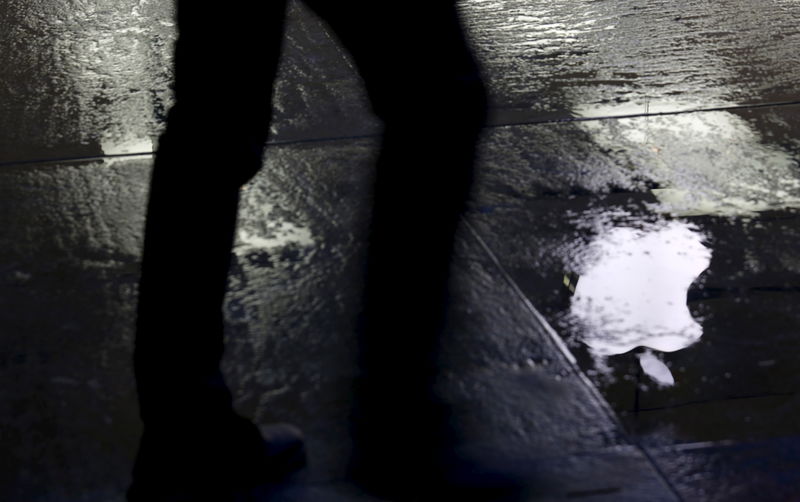(Bloomberg) -- The stock market’s cool response to the launch of Apple Inc's (NASDAQ:AAPL) mixed-reality headset left investors pondering what will provide the next push for a rally that has propelled the shares into record territory.
Having hit an all-time peak in the hours leading up to Monday’s product event, shares in the iPhone maker slipped 0.8% by the close and eased further in premarket trading as analysts said the eye-popping price of $3,499 for the Vision Pro headset would limit its mass-market appeal.
Morgan Stanley’s Erik Woodring is looking to October for the next potential catalyst, when he expects to learn more about initial headset volumes and precise timing of the launch. Much will depend on the development of a “killer app” that takes the new technology “from niche to mainstream,” he said in a note.
Given its lofty valuation, Apple needs newsflow to remain positive. After this year’s 38% rally, the stock is priced at 28 times profits projected over the next 12 months, according to data compiled by Bloomberg, the highest since early 2022. By contrast, the average multiple in the S&P 500 technology hardware and equipment index is 18 times, Apple’s average over the past decade.
The towering valuation is more a reflection of the firm’s balance-sheet strength, with all that means for buybacks and dividends, than it is of immediate growth prospects. Analysts expect sales this year to decline for the first time since 2016. What’s enticing investors the most is the longer-term durability of Apple’s revenue streams.
“I’m not concerned that it is more expensive than other hardware companies, because those never figured out how to turn a hardware story into a recurring platform business,” said Jonathan Curtis, director of portfolio management for Franklin Equity Group.
When it comes to the Vision Pro headset, the company’s ability to bring the product to a mass market will be crucial. And according to analysts at D.A. Davidson, there are “important structural challenges” in terms of its adoption by consumers “which could limit the near-term impact on its sales and profitability.” They downgraded the stock to neutral from buy after the event.
Angelo Zino, senior equity analyst at CFRA Research, said Apple failed to identify why the headset is a must-own device for consumers, “at least for now.” But of course, the muted market reaction doesn’t detract from the product’s long-term potential and Zino said he was “impressed by its best-in-class hardware/immersive capabilities.”
For Kim Forrest, chief investment officer and founder of Bokeh Capital Partners, Apple’s valuation hasn’t been compelling for years but that hasn’t stopped her and a vast majority of other portfolio managers from owning it.
“You buy it because it mints cash, the gravitational pull of it in the index makes you need to own it to keep up with the market,” she said. “They reliably, every ten years or so, come out with products we didn’t know we needed.”
Franklin’s Curtis is similarly optimistic. “Growth is going to ebb and flow, and we’re currently in an ebbing period, given tough Covid comps and maybe a slightly weakening consumer,” he said. “However, on a long-term perspective it will eventually flow again.”
Tech Chart of the Day
The Nasdaq 100 Index rose 1.7% last week, its sixth straight weekly advance. That six-week gain, which totaled about 12%, represents the longest such streak for the tech-heavy index since an eight-week rise that ended in July 2021. The index has climbed 33% this year.
Top Tech Stories
- Apple launched its first large-screen MacBook Air and new versions of the Mac Studio and Mac Pro, seeking to better compete with Windows PCs and reverse a sales slide that plagued its most recent earnings.
- Taiwan Semiconductor Manufacturing (NYSE:TSM) tempered its outlook for 2023 capital spending, as the main chipmaker to Apple grapples with soft demand for smartphone and computing chips.
- Intel Corp (NASDAQ:INTC), the largest US chipmaker by revenue, will sell part of its holdings in Mobileye Global Inc (NASDAQ:MBLY), raising about $1.48 billion for its ambitious spending plans.
- Byju’s, an education-technology company that provides services to more than 150 million students around the world, didn’t pay $40 million in interest due Monday on a $1.2 billion loan.
- The Japanese government revamped its chip strategy with a goal of tripling sales of domestically produced semiconductors to more than 15 trillion yen ($108 billion) by 2030, as the nation centers chips at the heart of its economic security policy.
